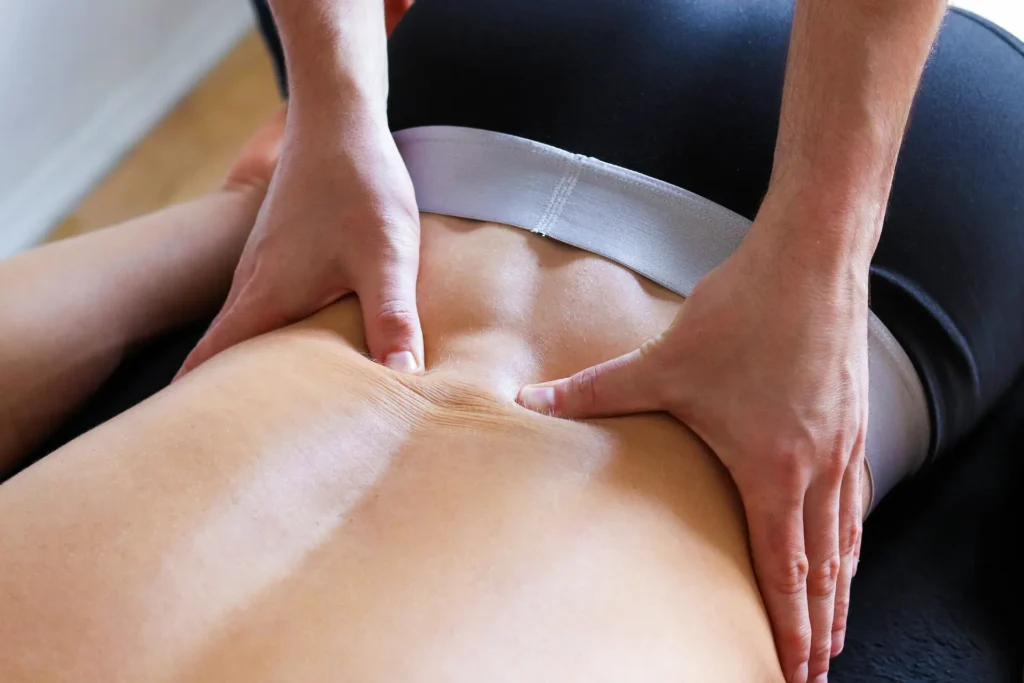Have you ever stood up from a chair and felt that deep ache at the very base of your spine? Or maybe you’ve noticed stiffness or pain in your lower back that just won’t quit—especially after sitting too long or first thing in the morning. You stretch, you move, maybe you pop a pain reliever or two—but it keeps coming back.
If this sounds familiar, you might be dealing with something called lumbosacral dysfunction, and trust me—you’re not alone. I see this condition all the time in my practice, and the good news is: bodywork therapy can help. Big time.
Let’s break down what’s going on—and how you can finally start to feel better.

The lumbosacral joint is the spot where your spine connects to your pelvis—right where your lower back ends and your tailbone begins. It’s a busy little area, carrying the weight of your whole upper body and helping your hips and spine move together.
When this joint isn’t working the way it should—because it’s tight, stuck, or out of balance—you get something we call lumbosacral dysfunction.
This can cause:
One of my clients, Trevor, came in thinking he had sciatica. But after checking his movement and muscle tension, we found that his lumbosacral joint was simply stuck. A few targeted sessions later, he was feeling better—no pills, no injections, just bodywork that helped his body move the way it’s supposed to.

This isn’t just a condition for athletes or people who lift heavy things. It can affect anyone—especially with the way most of us live and move these days.
Here are some common causes I see in my clients:
And here’s something most people don’t realize: when you sit too long, it’s not just your muscles that get stiff—your fascia does too. Fascia is the stretchy tissue that wraps around and supports your muscles. Without enough movement, it can dry out and get sticky, which pulls on nearby areas and makes everything feel tight. That deep, achy feeling in your lower back? Fascia is often part of the story.
Lumbosacral dysfunction is sneaky. It doesn’t always show up as sharp pain—sometimes it’s just that constant, low-level stiffness or tension that never quite goes away. But left untreated, it can spiral into bigger problems like sciatica, hip pain, or SI joint dysfunction.
I’ve had clients who didn’t even realize how much tension they were holding in their low back until we started working on it—and then suddenly, everything started moving easier.
Lumbosacral dysfunction isn’t just about a “bone being out of place.” It’s usually a mix of tight fascia, overworked muscles, stiff joints, and poor movement patterns.
Bodywork therapy looks at the whole picture—how your muscles, fascia, and joints are working together—and helps get everything back into balance.
At Bodywork Masters, we don’t just chase pain. We find the root of the problem and treat it with hands-on techniques that make a real difference.

We choose the right combination of techniques based on your body’s needs. Here are the most effective ones for lumbosacral dysfunction:
Fascia is the tissue that wraps around your muscles like a web. When it gets tight, it can pull on your spine and pelvis, making everything feel stiff or painful.
Using myofascial release with slow, gentle pressure, we release tight fascia in your:
Clients often tell me their lower back feels “lighter” or “freer” in their movement—even after one session.
This is one of our favorite ways to target deep tension in the hips and lower back. We use cupping, applying silicone or glass cups with gentle suction, often combined with heat, to improve blood flow, release muscle tension, and loosen up stuck fascia in the glutes and surrounding tissue.
Most people describe it as a deep, relaxing stretch from the inside out—and it can make a big difference in how your lower back moves and feels.
Sometimes your lumbosacral joint just isn’t moving well. Through joint therapy, we use gentle, safe techniques to help the joint glide and move the way it should—without any cracking or force.
This is especially helpful if your back pain gets worse when bending or twisting.
Tight “knots” in muscles can send pain to other areas. With trigger point therapy, we find those points—usually in the lower back, glutes, or hip muscles—and apply focused pressure to release them.
Many people feel noticeable relief right away after these points are released.
Once we’ve released the tight spots, we use assisted stretching to help you lengthen the right muscles to keep things moving well. This often includes:
We guide you through gentle stretches so you can feel what healthy movement should feel like again.
Here’s how we typically approach treating lumbosacral dysfunction:
These personalized sessions are designed specifically to address lower back pain at its root, not just the symptoms.

You don’t have to wait for your next appointment to support your healing. Try these simple things at home:
I give each of my clients personalized advice depending on their lifestyle and what’s causing their pain. A few small changes can make a big difference.
Most people notice some relief after just 1–2 sessions. Bigger improvements usually happen within 3–5 weeks of consistent treatment.
If you’ve had this pain for years, it might take a bit longer—but healing is still possible. I’ve worked with people who thought they’d “just have to live with it,” and they were amazed by how much better they felt after a personalized bodywork plan.
Lumbosacral dysfunction is often tied to other issues. If your pain travels down your leg, learn more about sciatica and how bodywork helps. If you have a deeper curve in your lower back, you may also want to read about Lordosis. And if your posture is off from the top down, Forward Head Posture can create compensatory tension all the way to your low back.
Treating one part of your body can often bring relief to others—because it’s all connected.

Lumbosacral dysfunction can make everything harder—from getting dressed to playing with your kids to simply sitting comfortably. But you don’t have to live with that pain.
Whether you’re dealing with severe SI joint pain, disc-related issues, or chronic lower back stiffness and pain, bodywork can help. Bodywork therapy offers a natural, hands-on solution that gets to the root of the problem. We help your body move the way it was meant to—without forcing, straining, or guessing.
Contact Bodywork Masters today to schedule your session. We’re here to help you feel strong, supported, and pain-free—so you can get back to doing the things you love.